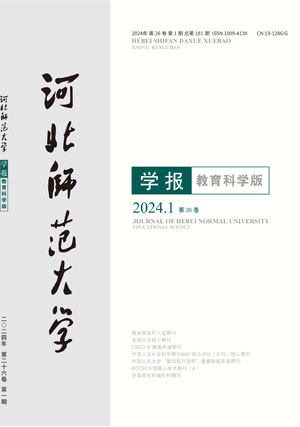期刊信息

- 刊名: 河北师范大学学报(教育科学版)Journal of Hebei Normal University (Educational Science Edition)
- 主办: 河北师范大学
- ISSN: 1009-413X
- CN: 13-1286/G
- 教育部名栏入选期刊
- 全国中文核心期刊
- CSSCI扩展版来源期刊
- AMI综合评价(A刊)核心期刊
- RCCSE中国核心学术期刊
- 全国高校特色栏目社科学报
- 中国人民大学“复印报刊资料”重要转载来源期刊
- 全国高校权威社科期刊
21世纪技能教学与学生核心素养:趋势与展望
-
作者单位:香港教育大学, 中国 香港 新界大埔 -
起止页码:72 - 76页 -
DOI:10.13763/j.cnki.jhebnu.ese.2017.03.017
Prospects on the 21st century skills and development of core qualifications
摘要/Abstract
“21世纪技能”受到国际教育界及学术界的重视,世界各国均根据其理念订下适用于其当地教与学情況的技能重点。与此同时,核心素养的概念也逐渐与21世纪技能的內容互相呼应,成为未来教育的新方向。国家于2016年发表《中国学生发展核心素养》,是未来教育发展的核心。文件当中列出六大素养,便是为学生适应转变中世界的发展注入新动力及引导新方向,进而提升国家教育的竞争力。从课程取向、教学取向和评估取向三大方向入手,揭示21世纪技能与核心素养之间的关系,发现核心素养如何为未来国家教育发展带来启示。
The 21st century skills have attracted international educators and academia so much that they act as a conception to guide the teaching and learning. Likewise, the core qualifications have turned to be the educational orientation as the core of education development. The core qualifications stipulated as six components in the 2016 Development of Core Qualifications for Chinese Students are new impetus that helps with competitiveness of the national education. This paper focuses on the relationships between the 21st century skills and development of core qualifications.
关键词
参考文献 31
- [ 1 ] 人民教育. 《中国学生发展核心素养》总体框架正式发布[EB/OL]. 2016-09-13.http://www.schoolbest.com/art/2016/10/10/art_1241_235738.html.
- [ 2 ] 褚宏启. 核心素养的国际视野与中国立场-21世纪中国的国民素质提升与教育目标转型[J]. 教育研究, 2016(11):8-18.
- [ 3 ] Canton, J. (2006). The extreme future:The top trends that will reshape the world in the next[M]. p.1. U.S.:Institute for Global Future.
- [ 4 ] 李子建, 姚伟梅, 许景辉编.二十一世纪技能与生涯规划教育[M]. 台北:高等教育出版社, 2017.
- [ 5 ] Griffin, P., McGraw, B. and Care, E. (2012). The changing role of education and schools[M]. In P. Griffin, B. McGaw, & E. Care (Eds.), Assessment and Teaching of 21st Century Skills (pp. 1-15). Dordrecht:Springer.
- [ 6 ] Binkley, M., Erstad, O., Herman, J., Raizen, S., Ripley, M., Miller-Ricci, M., & Rumble, M. (2012). Defining twenty-first century skills[M]. In P. Griffin, B. McGaw, & E. Care (Eds.), Assessment and Teaching of 21st Century Skills (pp. 17-66). Dordrecht:Springer.
- [ 7 ] Partnership for 21st Century Skills (2009). Curriculum and instruction:A 21st century skills implementation guide[M]. p.3.Tucson, Arizona.
- [ 8 ] 课程发展议会. 学会学习:终身学习全人发展[M]. 香港:政府印务局, 2001.
- [ 9 ] 沈音. 浅谈对《中国学生发展核心素养》的认识[EB/OL]. http://fhxx.com.cn/post-yojyamcmyzjithtpio8n0a.
- [ 10 ] 李子建, 黃显华. 课程:范式、取向和设计(第2版)[M]. 香港:中文大学出版社/台湾:五南图书出版公司, 1996.
- [ 11 ] Eisner, E.W., & Vallance, E. (1974) Introduction-Five conceptions of curriculum:Their roots and implications for curriculum planning[M]. In E.W. Eisner and E. Vallance (Eds.), Conflicting conceptions of curriculum (pp. 1-18). Berkeley, CA:McCutchan.
- [ 12 ] 李子建. 学生发展核心素养与语文素养[J]. 小学语文, 2017.
- [ 13 ] 王秉豪, 李子建, 朱小蔓, 欧用生.生命教育的知、情、意、行[M]. 台湾新北市:扬智文化, 2016.
- [ 14 ] 李文富. 从大学的发展趋势探析十二年国民基本教育普通高中阶段的课程改革[J]. 课程研究, 2013(2):53-75.
- [ 15 ] 赵婀娜. 今天,为何要提"核心素养"(深聚焦)[N].人民日报,2016-10-13(20).
- [ 16 ] 李子建. 校本课程发展、教师发展与伙伴协作[M].北京:教育科学出版社, 2010.
- [ 17 ] 李子建,邱德峰.学生自主学习:教学条件与策略[J].全球教育展望,2017(1):47-57.
- [ 18 ] 蔡清田. 课程发展与设计的关键DNA核心素养[M]. 台湾:五南图书出版股份有限公司, 2012.
- [ 19 ] National Education Association (NEA) (u.d.) Preparing 21st century students for a global society:An educator's guide to the "4C"[M]. p.20. Retrieved 15th January 2017 from, http://www.nea.org/assets/docs/A-Guide-to-Four-Cs.pdf.
- [ 20 ] 加里·R·卡比, 杰弗里·R·古德帕斯特. 批判性思维与创造性思维(第4版)[M]. 韩广忠, 译. 北京:中国人民大学出版社, 2016.
- [ 21 ] 顾明远. 新时期教育家的成长之路[J]. 河北师范大学学报(教育科学报), 2016(6):5-8.
- [ 22 ] 岳欣云, 董宏建. 有效教学的价值取向及其启示[J]. 首都师范大学学报(社会科学版), 2014(2):152-156.
- [ 23 ] 许景辉, 麦震岚. 二十一世纪生涯规划教育[A]. 载自李子建, 姚伟梅, 许景辉. 二十一世纪技能与生涯规划教育[C]. 台北:高等教育出版社, 2017.
- [ 24 ] Qualification and Curriculum Authority (QCA) (n.d). Building a 21st century curriculum:Looking after learners, today and tomorrow. Powerpoint presentation[M]. pp.6-16. Retrieved 15th January 2017 from,www.devon.gov.uk/daph-presentation.pdf.
- [ 25 ] Acedo, C. and Hughes, C. (2014). Principles for learning and competences in the 21st-century curriculum[J]. Prospects, 44, 503-525.
- [ 26 ] 李子建, 尹弘飚. 课堂环境对香港学生自主学习的影响——兼论"教师中心"与"学生中心"之辩[J]. 北京大学教育评论, 2010(1):70-82.
- [ 27 ] Lee, J.C.K. (2014). Curriculum and teaching reforms:Challenges and prospects[M]. In C. Marsh and J.C.K. Lee (Eds.), Asia's high performing education systems:The case of Hong Kong (pp.338-354). New York/London:Routledge.
- [ 28 ] Institute for the Future (2013). From Educational Institutions to Learning Flows[M]. U.S.:Institute for the Future, p.1.
- [ 29 ] Toffler, A. (1971). Future Shock[M]. p.314. (10th ed) US:Bantam Publisher.
- [ 30 ] Drexler, W. (2010). The networked student model for construction of personal learning environments:Balancing teacher control and student autonomy[J]. Australasian Journal of Educational Technology, 26(3), 369-385. https://ajet.org.au/index.php/AJET/article/viewFile/1081/338.
- [ 31 ] 张钿富. 教育概论(增订3版)[M]. 台湾:三民出版社, 2013.
